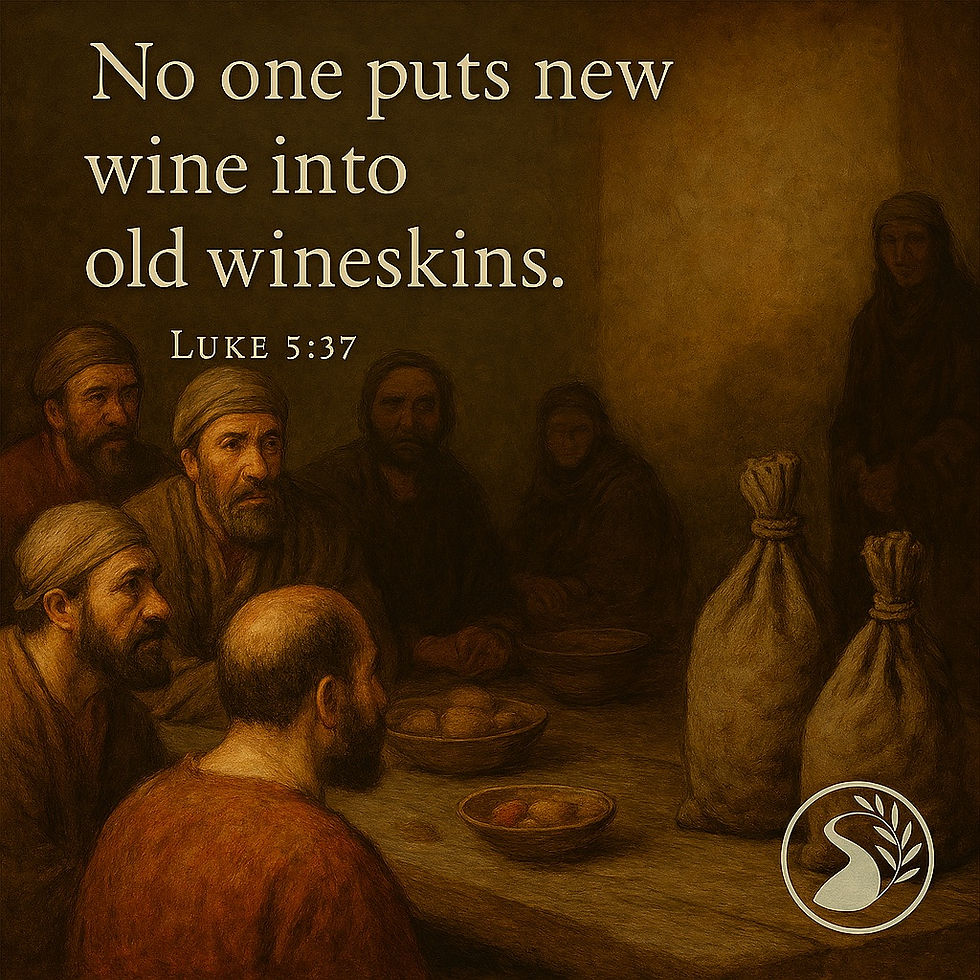Old and New Wineskins-What?
- Leisa Baysinger

- Sep 22
- 4 min read
New Wine, Old Wineskins: Yeshua’s Call to Renewal

Luke 5:33-39
Modern Christian commentators would lead us to believe that the old wineskins, old wine, and the old cloth are Judaism or the “law” and that Yeshua is telling them that these are now obsolete. They teach that the “new wine” and the “new wineskins” and the “new cloth” have come which is the beginnings of Christianity, the church, and the grace dispensation that has been instituted by Yeshua. They would argue that in this parable, Yeshua is coming against Judaism and Torah and instituting the new "church." The old covenant/Judaism is old and obsolete and the new covenant/church must begin with a new movement. The new has erased or replaced the old.
However, verse 39 (Luke 5:39) then would pose a real problem if this were true because it states that the “old wine is better.” To get around this verse, many claim that this phrase is only used in Luke’s version and not Matthew or Mark's (parable told in Matthew 9:16,17, Mark 2:21,22 and Luke 5:36-39) and they argue that it was later added to refute that Yeshua had done away with the practices of Judaism and Torah. To that I would say - ridiculous!!!
So, what is really going on here?
First, what was the real problem when Yeshua spoke this parable? The real problem was that the Pharisees and scribes didn’t like or questioned Yeshua’s methods and choice of disciples. If He was a teacher of Torah, then what was the deal with His apparently “poor” choice of disciples?
Spoken at a banquet hosted by Levi the tax collector, the parable is Yeshua’s response to religious leaders questioning why his disciples don’t fast like those of the Pharisees or John the Immerser. But beneath the surface, it’s a defense of his radical choice of followers and a prophetic critique of spiritual rigidity.
Yeshua had just called Levi, a tax collector, to be his disciple, a move that scandalized the religious elite. His table was filled with “sinners,” outcasts, and those deemed unworthy by traditional standards. The Pharisees stood nearby, observing but unwilling to join the feast. Their question about fasting wasn’t just about ritual, it was about legitimacy. Why would a supposed teacher of Torah surround himself with the spiritually unclean?
Yeshua’s double parable, of a torn garment patched with new cloth and new wine poured into old wineskins, was his answer. The metaphors reveal the incompatibility between the fresh movement of the Kingdom and the rigid structures of religious tradition. DT Lancaster (1) emphasizes that Yeshua wasn’t discarding Torah but rather challenging the inability of old frameworks to contain the fermenting truth of grace, renewal, and inclusion.
The parable here is not about the contents of the vessel but about the vessel itself.
His choice of disciples becomes central: Yeshua was pouring new wine into new vessels, men like a tax collector named Levi, fishermen like Peter, James and John, and a zealot named Simon. These men were seen as untrained and unskilled in Torah and rabbinic tradition, but they were open to transformation. The old wineskins, represented by the Pharisees and other critics, could not stretch to accommodate this new reality. Their spiritual containers had hardened.
The parable pits Yeshua’s choice of disciples against the Pharisee's choice of disciples. He is basically saying, “I will choose to teach them the correct way, while they are fresh and new. Then, when I am done with them, they will not be perceived to be uneducated or unlearned in Torah anymore, and they won’t need to be taught by you.”
In Acts 4:13 we in fact read:
Now when they saw the boldness of Peter and John and figured out they were laymen without training, they were amazed. They began to realize that these men had been with Yeshua.
It was Yeshua who did the teaching! The perfect way.
Its new meaning would suggest that Yeshua is saying new teaching requires previously uneducated students in order to be received. To put it in modern terms, He was saying something like this: "you are all set in your ways, and I can’t teach an old dog a new trick.” So, therefore, He was choosing the uneducated (in higher Torah education), and the outcasts (publicans and sinners) who needed a physician, to teach the Renewed Covenant. He would (and will) teach those willing and eager to learn the correct way to live, teaching them Torah and the salvation offered by the One that the Torah said would come.
There are similar parables told in the Oral Law.
Lancaster’s use of the Talmudic story from Nedarim 50b—about Torah stored in “ugly vessels”—adds depth. Just as wine spoils in golden jars, spiritual truth can sour when forced into ornate but inflexible systems. Yeshua’s disciples were clay jars, ordinary, flawed, but ready to be filled.
This section of scripture should make us reflect on our own spiritual posture. Are we willing to become new wineskins: flexible, humble, and open to the Spirit’s fermenting work, or do we cling to the familiar, saying, “The old is better?”
We must be willing to carry ancient truths into fresh expressions of beauty and power in order to build a bridge for those crossing over.
Blessings,
Leisa
Bibliography:
bethimmauel.org by D.T. Lancaster New Wine and Old Wineskins







Comments